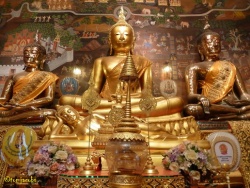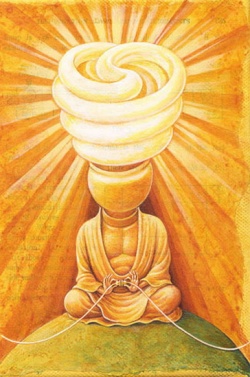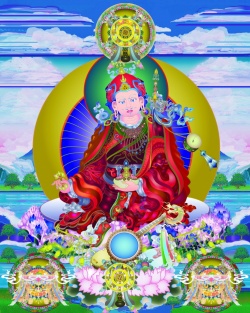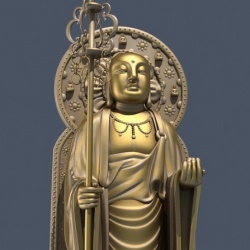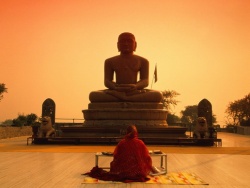Difference between revisions of "Addition of Rituals to Buddhist Practices"
| (2 intermediate revisions by 2 users not shown) | |||
| Line 1: | Line 1: | ||
{{DisplayImages|1360|1895|18|522|476|959|1359}} | {{DisplayImages|1360|1895|18|522|476|959|1359}} | ||
| + | |||
| + | |||
| + | |||
| + | |||
| + | |||
| + | |||
| + | |||
| + | |||
<poem> | <poem> | ||
[[Rituals]] in [[Buddhist Practices]]: | [[Rituals]] in [[Buddhist Practices]]: | ||
| − | [[Buddhism]] is devoid of any {{Wiki|ceremony}} or [[ritual]] of [[initiation]] or admission, such as the [[Upanayana]] in [[Hinduism]] or baptism in Christianity.ԚÂ The [[traditional]] method of becoming a [[Buddhist]] is to observe the Three-Refuges (tisarana) and the Five-Precepts ( | + | [[Buddhism]] is devoid of any {{Wiki|ceremony}} or [[ritual]] of [[initiation]] or admission, such as the [[Upanayana]] in [[Hinduism]] or baptism in Christianity.ԚÂ The [[traditional]] method of becoming a [[Buddhist]] is to observe the Three-Refuges ([[tisarana]]) and the [[Five-Precepts]] (pañ ca-[[sila]]) with the [[Confidence]] of the [[Triple Gem]] (the [[Buddha]], the [[Dhamma]], and the [[Sangha]]). [[Confidence]] ([[shradha]] in [[Buddhism]] is not the same as [[Faith]] ([[bhaktiya]]). In the practice of [[Buddhism]], it is also important to understand the meanings of [[Buddhist]] [[stanzas]] that are usually recited in [[Pali]]. ‚ Recitation without [[understanding]] the meaning or [[commitments]] involved serves no {{Wiki|purpose}}.‚ [[Traditionally]], the [[Three Refuges]] are delivered by a [[Buddhist monk]], but this is not [[essential]]. ‚ [[Three Refuges]] are: |
| − | Buddham saranam | + | Buddham saranam gacch I go to the [[Buddha]] for [[refuge]]. |
| − | Dhammam saranam | + | Dhammam saranam gacch I go to the [[Dhamma]] for [[refuge]]. |
| − | Sangham saranam | + | Sangham saranam gacch I go to the [[Sangha]] for [[refuge]]. |
| − | This [[affirmation]] of [[Confidence]] in the [[Triple Gem]] (tisarana) is repeated for a second [[time]] (e.g., dutiyampi Buddham saranam gacchãmi, etc.), and a third [[time]] ( | + | This [[affirmation]] of [[Confidence]] in the [[Triple Gem]] ([[tisarana]]) is repeated for a second [[time]] (e.g., dutiyampi Buddham saranam gacchãmi, etc.), and a third [[time]] ([[tatiyampi]]…). After this, the [[devotee]] repeats the [[Five Precepts]], which are meant as a reminder to [[discipline]] in the [[Buddhist]] [[moral]] [[life]]. ‚ However, it is up to the {{Wiki|individual}} to keep these [[moral]] values as [[taught]] by the [[Buddha]]. |
| − | For [[Buddhist]] {{Wiki|devotees}}, the [[ritual]] of {{Wiki|worship}} is nothing more than a respectful [[recognition]] of the greatness of the [[Buddha]] as a [[spiritual]] teacher. | + | For [[Buddhist]] {{Wiki|devotees}}, the [[ritual]] of {{Wiki|worship}} is nothing more than a respectful [[recognition]] of the greatness of the [[Buddha]] as a [[spiritual]] [[teacher]]. ‚ It is an expression of [[gratitude]] to the [[Buddha]] for having discovered and revealed the [[path]] leading to the elimination of [[human]] [[suffering]] ‚ The whole affair becomes a futile exercise if the participants merely reciting [[stanzas]] in a parrot-like fashion, or does not adhere to the [[Five-Precepts]]. |
[[Offering]] of [[Flowers]]: | [[Offering]] of [[Flowers]]: | ||
| − | Of the many articles of [[offering]] used during {{Wiki|worship}}, [[flowers]] have become the most popular.ԚÂ ԚÂ Some [[Buddhists]] consider [[flowers]] a requirement in [[devotion]] to the [[religious]] conviction. | + | Of the many articles of [[offering]] used during {{Wiki|worship}}, [[flowers]] have become the most popular.ԚÂ ԚÂ Some [[Buddhists]] consider [[flowers]] a requirement in [[devotion]] to the [[religious]] conviction. ‚ The {{Wiki|colour}} ([[vanna]]), {{Wiki|smell}} ([[gandha]]), and [[quality]] (gunã) of the [[flowers]] are taken into account when selecting them for offering.ԚÂ ԚÂ During the [[offering]] of [[flowers]], {{Wiki|devotees}} recite the following [[stanza]]: |
| − | Vannagandha-gunopetam | + | Vannagandha-gunopetam etam kusuma-santatim |
| − | pujayãmi munindassa | + | pujayãmi munindassa siripada-saroruhe. |
Pujemi Buddham kusumena â┚¬Ã¢”ž¢nena â┚¬Ã¢â‚¬ punnena â┚¬Ã¢”ž¢metena ca hotu mokkham | Pujemi Buddham kusumena â┚¬Ã¢”ž¢nena â┚¬Ã¢â‚¬ punnena â┚¬Ã¢”ž¢metena ca hotu mokkham | ||
| − | Puppham milayati yatha idam me â┚¬Ã¢â‚¬ kayo [[tatha]] yati vinasabahavam | + | Puppham milayati [[yatha]] idam me â┚¬Ã¢â‚¬ kayo [[tatha]] [[yati]] vinasabahavam |
| − | This [[stanza]] means, “With this mass of [[flowers]], endowed with {{Wiki|colour}}, {{Wiki|fragrance}}, and quality, I venerate the [[Buddha]], the [[King]] of wise. | + | This [[stanza]] means, “With this {{Wiki|mass}} of [[flowers]], endowed with {{Wiki|colour}}, {{Wiki|fragrance}}, and [[quality]], I venerate the [[Buddha]], the [[King]] of [[wise]]. I {{Wiki|worship}} the [[Buddha]] with these [[flowers]]: by the [[merit]] of this may I attain [[liberation]]. ‚ As these [[flowers]] fade and wither, so will my [[body]], [[decay]]. Importantly, this [[stanza]] incorporates the key [[Buddhist philosophy]] of the “[[impermanence]] ‚ (aniccã) of all material and [[phenomena]]. |
| − | Customarily, before being [[offered]], the [[flowers]] are | + | Customarily, before being [[offered]], the [[flowers]] are “bathed ‚ with filtered [[water]] (pan). Sometimes they are arranged in a tray ([[vattiya]]) before being [[offered]]. What is the [[symbolic]] meaning for this? [[Flowers]] blooming upon [[contact]] with {{Wiki|light}} and keeping fresh with a {{Wiki|touch}} of [[water]] are regarded as [[symbolic]] of the [[attainment]] of [[Enlightenment]]; thus, [[flowers]] become quite a fitting [[offering]] to the [[Buddha]], the [[Enlightened]] One. ‚ However, the [[offering]] of [[flowers]] is not an [[essential]] part of [[Confidence]] ([[shradha]] ) or the practice of [[Buddhism]]. Consequently, if one has the right [[mental]] [[attitude]], whether one offers none, one, or 1,000 [[flowers]], it makes no difference. |
[[Offering]] of Light: | [[Offering]] of Light: | ||
| − | Another popular [[offering]] of much importance is that of [[incense]] and lighted lamps; usually the lamps are lit with coconut oil, customarily called pahan-puja. | + | Another popular [[offering]] of much importance is that of [[incense]] and lighted lamps; usually the lamps are lit with coconut oil, customarily called [[pahan-puja]]. ‚ The {{Wiki|theoretical}} basis for this practice is that the [[Buddha]] is regarded as the “dispeller of the {{Wiki|darkness}} of [[ignorance]]”; so lighted lamps are [[offered]] in his [[name]], [[symbolizing]] the contrast between, “achieving [[knowledge]] and eliminating the {{Wiki|darkness}} of [[ignorance]]. ‚ Consequently, whether one lights one [[lamp]] or 1000 lamps, it makes no difference. What matters is the [[Right thought]] and the [[Right intention]]. [[Understanding]] teachings of the [[Buddha]], and how one can lay the [[path]] to eliminate one [[own]] “[[ignorance]] by enhancing one [[mental]] ability to develop [[Wisdom]] is what’s important. Nevertheless, this practice has often become a meaningless routine [[ritual]]. |
| − | The [[symbolism]] of lighting lamps is simply a [[tradition]] for some. | + | The [[symbolism]] of lighting lamps is simply a [[tradition]] for some. Their {{Wiki|motive}} for this [[ritual]] is usually to satisfy the [[desires]] to acquire [[merit]] or to avert the [[evil]] influence of bad {{Wiki|planetary}} [[actions]]. Nevertheless, the [[offering]] is supposed to remind the follower to understand the importance of …“the [[Wisdom]] versus [[Ignorance]]. {{Wiki|Devotees}} make such [[offerings]] by reciting the following [[Pali]] [[stanza]]: |
Ghanasarãppa-dittena â┚¬Ã¢â‚¬ dipena tama-damsina | Ghanasarãppa-dittena â┚¬Ã¢â‚¬ dipena tama-damsina | ||
Tilokadipam sambuddham â┚¬Ã¢â‚¬ pujayami tamonudam | Tilokadipam sambuddham â┚¬Ã¢â‚¬ pujayami tamonudam | ||
| − | This [[stanza]] means, â┚¬Ã…“With this [[lamp]], I dispel the darkness; I venerate the perfectly [[Enlightened One]], who is a [[lamp]] unto the [[three worlds]] and is the dispeller of the darkness of delusion.â┚¬Ã‚ | + | This [[stanza]] means, â┚¬Ã…“With this [[lamp]], I dispel the {{Wiki|darkness}}; I venerate the perfectly [[Enlightened One]], who is a [[lamp]] unto the [[three worlds]] and is the dispeller of the {{Wiki|darkness}} of delusion.â┚¬Ã‚ |
| − | The {{Wiki|epithets}} tilokadipa | + | The {{Wiki|epithets}} [[tilokadipa]] “[[lamp]] unto the [[three worlds]] ‚) and [[tamonuda]] ( “[[dispeller of darkness]] ) as applied to the [[Buddha]] are significant in this context. The [[stanza]] itself seems to testify to the [[popularity]] of the [[offering]] of {{Wiki|camphor}} (ghanasarã) in early times. However, today even when coconut oil has replaced {{Wiki|camphor}}, the [[stanza]] continues using the same verses. The importance is to understand the meaning of these [[stanzas]], and not the glory or the numbers of lamps lighted. |
| − | As per the chronicles, the [[offering]] of lighted lamps has been a popular [[ritual]] since {{Wiki|ancient}} times. | + | As per the chronicles, the [[offering]] of lighted lamps has been a popular [[ritual]] since {{Wiki|ancient}} times. The [[Bodhi-tree]] and [[dagabas]] (also referred to as [[stupa]], [[chetiya]]) are the two main [[objects]] or sites where this practice is usually performed. The [[offering]] of lamps is one of the main aspects of the {{Wiki|worship}} of the [[Bodhi-tree]] ([[bodhi-puja]]). The [[understanding]] behind this is that it was under a [[Bodhi-tree]] that the [[Buddha]] [[attained]] [[Enlightenment]]. Thus, it is natural that lamps are lit under such [[trees]], not only in [[memory]] of the great event, but also as a practice whereby the [[devotee]] can expect to obtain a ray of that {{Wiki|light}} of [[Wisdom]] [[attained]] by the Great [[Sage]]. Thus, this practice can be considered a [[spiritual]] exercise. {{Wiki|Devotees}} then transfer the obtained [[merits]] to [[humans]], [[deities]], and deceased relatives. |
| − | [[Offering]] to Dagabas: | + | [[Offering]] to [[Dagabas]]: |
| − | [[Dagaba]] ([[chaitya]]) is another place where [[offerings]] are made. | + | [[Dagaba]] ([[chaitya]]) is another place where [[offerings]] are made. ‚ Consequently, along with the [[flower]] [[altars]], the [[lamp]] stands have become accessories of the [[dagaba]]. One can also see these around Bo-trees in most [[temples]]. Platforms of special [[lamp]] stands are built with metal, brick, or stone, and places are made to hold oil lamps. In some [[Buddhist]] [[temples]], there is a special [[lamp]], called the [[dolosmahe-pahana]] (12-month [[lamp]]), which is expected to keep burning year-round; it is a special [[symbol]] for [[Spiritualism]] and [[Wisdom]]. |
| − | It has also become customary for some to perform the [[ritual]] of light [[offering]] (pahan-puja) to counter [[evil]] {{Wiki|planetary}} influences. | + | It has also become customary for some to perform the [[ritual]] of {{Wiki|light}} [[offering]] ([[pahan-puja]]) to counter [[evil]] {{Wiki|planetary}} [[influences]]. Coconut oil that is used for [[illuminating]], is at times specially prepared for the occasion, and wicks are prepared from a clean, white, fresh cloth. Sometimes an entire village or group of [[people]] or an [[organization]] holds a {{Wiki|mass}} [[lamp offering]], during which 84,000 lighted lamps are [[offered]] in [[memory]] of the 84,000 [[elements]] of the [[Dhamma]] ([[dhammakkhandha]]) comprising the [[Buddha]] [[teaching]]. Whether such practices are considered a {{Wiki|social}} event or a [[spiritual]] event depends on the [[understanding]] and the motives of the [[people]] who organize and participate in such events. |
| − | Another [[ritual]] is to have special light or [[illumination]] [[offerings]] made on [[auspicious]] occasions. | + | Another [[ritual]] is to have special {{Wiki|light}} or [[illumination]] [[offerings]] made on [[auspicious]] occasions. As a part of the homage to [[Buddha]], on special occasions such as [[full moon]] days, person’s [[birthday]], fulfilling a , or on [[Vesak]] Day (to celebrate the [[birth]] and the [[Enlightened]] of the [[Buddha]]), [[flowers]] are [[offered]] and oil lamps are lighted. {{Wiki|Devotees}} offer a large number of lamps for these special occasions. |
| − | Some [[Buddhist]] [[rituals]] have been practiced since {{Wiki|ancient}} times in [[Sri Lanka]]. | + | Some [[Buddhist]] [[rituals]] have been practiced since {{Wiki|ancient}} times in [[Sri Lanka]]. For example, [[King]] [[Dutugemunu]] (2nd century B.C.) is recorded to have lit 1,000 lamps with ghee as the [[lamp]] fuel; these lamps had white wicks and burned perpetually in 12 [[sacred]] places in [[Anuradhapura]] 37). [[King]] [[Vasabha]] (1st century A.C.) is said to have lit 1,000 oil lamps at [[Cetiyapabbata]], [[Thuparama]], Mahathupa (Ruvanweli-dagaba) and the [[Bodhi-tree]] xxxvi, 80). |
| − | Today, this [[ritual]] has become so popular and elaborate that the annual [[Vesak]] {{Wiki|festival}}, commemorating the [[birth]], [[Enlightenment]], and [[Parinibbana]] of the [[Buddha]], has become more or less a | + | Today, this [[ritual]] has become so popular and elaborate that the annual [[Vesak]] {{Wiki|festival}}, commemorating the [[birth]], [[Enlightenment]], and [[Parinibbana]] of the [[Buddha]], has become more or less a “{{Wiki|festival}} of lights, but in many cases has lost the [[spiritual]] meaning. [[Vesak]] lanterns of various kinds, {{Wiki|colour}}, and shapes are lit in [[Buddhist]] establishments and in homes, on this day.ԚÂ ԚÂ Large decorated and [[illuminated]] structures (thoran, pandols) are [[illuminated]] with multi-coloured electric bulbs, depicting various scenes from the [[life of the Buddha]] and from the [[Jataka]] stories. These have become an important {{Wiki|social}} venture in some [[Buddhist]] countries. |
| − | [[Rituals]] are not a part of [[Wikipedia:Authenticity|authentic]] [[Theravada]] Buddhism. | + | [[Rituals]] are not a part of [[Wikipedia:Authenticity|authentic]] [[Theravada]] [[Buddhism]]. For various [[reasons]], over the years, these artefacts have been brought into the practice of [[Buddhism]]. The next article (#4) will further review the [[rituals]] and {{Wiki|realistic}} approaches to [[Buddhism]]. |
| − | + | “All [[conditioned things]] are [[impermanent]]; when one sees this with [[Wisdom]], then one becomes dispassionate toward the [[painful]] ([[samsara]]): this is the [[Path]] to Purityâ┚¬Ã‚ ([[Dhammapada]]) | |
| − | + | Note: Some of the material, pictures, and [[poems]] have been published previously or obtained from the [[Internet]] (e.g., http://what-buddha-said.net; Buddha.Direct.net, etc.) and other sources, and modified, reproduced with approval. The author sincerely thanks all contributors of such materials for their [[generosity]]. | |
| − | PS: | + | PS: This and the next article (#4) are written in response to the discussions in the article number 2. |
| − | We {{Wiki|hope}} that these brief articles on [[meditation]], [[Buddhism]], and [[Buddhist philosophy]] will initiate healthy and positive discussions. | + | We {{Wiki|hope}} that these brief articles on [[meditation]], [[Buddhism]], and [[Buddhist philosophy]] will [[initiate]] healthy and positive discussions. |
May the [[Noble]] [[Triple Gem]] bless you | May the [[Noble]] [[Triple Gem]] bless you | ||
| Line 69: | Line 77: | ||
{{R}} | {{R}} | ||
[http://www.lankaweb.com/news/items/2011/02/27/addition-of-rituals-to-buddhist-practices/ www.lankaweb.com] | [http://www.lankaweb.com/news/items/2011/02/27/addition-of-rituals-to-buddhist-practices/ www.lankaweb.com] | ||
| − | [[Category: | + | [[Category:Rituals]] |
Latest revision as of 07:02, 17 February 2024
Rituals in Buddhist Practices:
Buddhism is devoid of any ceremony or ritual of initiation or admission, such as the Upanayana in Hinduism or baptism in Christianity.ԚÂ The traditional method of becoming a Buddhist is to observe the Three-Refuges (tisarana) and the Five-Precepts (pañ ca-sila) with the Confidence of the Triple Gem (the Buddha, the Dhamma, and the Sangha). Confidence (shradha in Buddhism is not the same as Faith (bhaktiya). In the practice of Buddhism, it is also important to understand the meanings of Buddhist stanzas that are usually recited in Pali. ‚ Recitation without understanding the meaning or commitments involved serves no purpose.‚ Traditionally, the Three Refuges are delivered by a Buddhist monk, but this is not essential. ‚ Three Refuges are:
Buddham saranam gacch I go to the Buddha for refuge.
Dhammam saranam gacch I go to the Dhamma for refuge.
Sangham saranam gacch I go to the Sangha for refuge.
This affirmation of Confidence in the Triple Gem (tisarana) is repeated for a second time (e.g., dutiyampi Buddham saranam gacchãmi, etc.), and a third time (tatiyampi…). After this, the devotee repeats the Five Precepts, which are meant as a reminder to discipline in the Buddhist moral life. ‚ However, it is up to the individual to keep these moral values as taught by the Buddha.
For Buddhist devotees, the ritual of worship is nothing more than a respectful recognition of the greatness of the Buddha as a spiritual teacher. ‚ It is an expression of gratitude to the Buddha for having discovered and revealed the path leading to the elimination of human suffering ‚ The whole affair becomes a futile exercise if the participants merely reciting stanzas in a parrot-like fashion, or does not adhere to the Five-Precepts.
Offering of Flowers:
Of the many articles of offering used during worship, flowers have become the most popular.ԚÂ ԚÂ Some Buddhists consider flowers a requirement in devotion to the religious conviction. ‚ The colour (vanna), smell (gandha), and quality (gunã) of the flowers are taken into account when selecting them for offering.ԚÂ ԚÂ During the offering of flowers, devotees recite the following stanza:
Vannagandha-gunopetam etam kusuma-santatim
pujayãmi munindassa siripada-saroruhe.
Pujemi Buddham kusumena â┚¬Ã¢”ž¢nena â┚¬Ã¢â‚¬ punnena â┚¬Ã¢”ž¢metena ca hotu mokkham
Puppham milayati yatha idam me â┚¬Ã¢â‚¬ kayo tatha yati vinasabahavam
This stanza means, “With this mass of flowers, endowed with colour, fragrance, and quality, I venerate the Buddha, the King of wise. I worship the Buddha with these flowers: by the merit of this may I attain liberation. ‚ As these flowers fade and wither, so will my body, decay. Importantly, this stanza incorporates the key Buddhist philosophy of the “impermanence ‚ (aniccã) of all material and phenomena.
Customarily, before being offered, the flowers are “bathed ‚ with filtered water (pan). Sometimes they are arranged in a tray (vattiya) before being offered. What is the symbolic meaning for this? Flowers blooming upon contact with light and keeping fresh with a touch of water are regarded as symbolic of the attainment of Enlightenment; thus, flowers become quite a fitting offering to the Buddha, the Enlightened One. ‚ However, the offering of flowers is not an essential part of Confidence (shradha ) or the practice of Buddhism. Consequently, if one has the right mental attitude, whether one offers none, one, or 1,000 flowers, it makes no difference.
Offering of Light:
Another popular offering of much importance is that of incense and lighted lamps; usually the lamps are lit with coconut oil, customarily called pahan-puja. ‚ The theoretical basis for this practice is that the Buddha is regarded as the “dispeller of the darkness of ignorance”; so lighted lamps are offered in his name, symbolizing the contrast between, “achieving knowledge and eliminating the darkness of ignorance. ‚ Consequently, whether one lights one lamp or 1000 lamps, it makes no difference. What matters is the Right thought and the Right intention. Understanding teachings of the Buddha, and how one can lay the path to eliminate one own “ignorance by enhancing one mental ability to develop Wisdom is what’s important. Nevertheless, this practice has often become a meaningless routine ritual.
The symbolism of lighting lamps is simply a tradition for some. Their motive for this ritual is usually to satisfy the desires to acquire merit or to avert the evil influence of bad planetary actions. Nevertheless, the offering is supposed to remind the follower to understand the importance of …“the Wisdom versus Ignorance. Devotees make such offerings by reciting the following Pali stanza:
Ghanasarãppa-dittena â┚¬Ã¢â‚¬ dipena tama-damsina
Tilokadipam sambuddham â┚¬Ã¢â‚¬ pujayami tamonudam
This stanza means, â┚¬Ã…“With this lamp, I dispel the darkness; I venerate the perfectly Enlightened One, who is a lamp unto the three worlds and is the dispeller of the darkness of delusion.â┚¬Ã‚
The epithets tilokadipa “lamp unto the three worlds ‚) and tamonuda ( “dispeller of darkness ) as applied to the Buddha are significant in this context. The stanza itself seems to testify to the popularity of the offering of camphor (ghanasarã) in early times. However, today even when coconut oil has replaced camphor, the stanza continues using the same verses. The importance is to understand the meaning of these stanzas, and not the glory or the numbers of lamps lighted.
As per the chronicles, the offering of lighted lamps has been a popular ritual since ancient times. The Bodhi-tree and dagabas (also referred to as stupa, chetiya) are the two main objects or sites where this practice is usually performed. The offering of lamps is one of the main aspects of the worship of the Bodhi-tree (bodhi-puja). The understanding behind this is that it was under a Bodhi-tree that the Buddha attained Enlightenment. Thus, it is natural that lamps are lit under such trees, not only in memory of the great event, but also as a practice whereby the devotee can expect to obtain a ray of that light of Wisdom attained by the Great Sage. Thus, this practice can be considered a spiritual exercise. Devotees then transfer the obtained merits to humans, deities, and deceased relatives.
Offering to Dagabas:
Dagaba (chaitya) is another place where offerings are made. ‚ Consequently, along with the flower altars, the lamp stands have become accessories of the dagaba. One can also see these around Bo-trees in most temples. Platforms of special lamp stands are built with metal, brick, or stone, and places are made to hold oil lamps. In some Buddhist temples, there is a special lamp, called the dolosmahe-pahana (12-month lamp), which is expected to keep burning year-round; it is a special symbol for Spiritualism and Wisdom.
It has also become customary for some to perform the ritual of light offering (pahan-puja) to counter evil planetary influences. Coconut oil that is used for illuminating, is at times specially prepared for the occasion, and wicks are prepared from a clean, white, fresh cloth. Sometimes an entire village or group of people or an organization holds a mass lamp offering, during which 84,000 lighted lamps are offered in memory of the 84,000 elements of the Dhamma (dhammakkhandha) comprising the Buddha teaching. Whether such practices are considered a social event or a spiritual event depends on the understanding and the motives of the people who organize and participate in such events.
Another ritual is to have special light or illumination offerings made on auspicious occasions. As a part of the homage to Buddha, on special occasions such as full moon days, person’s birthday, fulfilling a , or on Vesak Day (to celebrate the birth and the Enlightened of the Buddha), flowers are offered and oil lamps are lighted. Devotees offer a large number of lamps for these special occasions.
Some Buddhist rituals have been practiced since ancient times in Sri Lanka. For example, King Dutugemunu (2nd century B.C.) is recorded to have lit 1,000 lamps with ghee as the lamp fuel; these lamps had white wicks and burned perpetually in 12 sacred places in Anuradhapura 37). King Vasabha (1st century A.C.) is said to have lit 1,000 oil lamps at Cetiyapabbata, Thuparama, Mahathupa (Ruvanweli-dagaba) and the Bodhi-tree xxxvi, 80).
Today, this ritual has become so popular and elaborate that the annual Vesak festival, commemorating the birth, Enlightenment, and Parinibbana of the Buddha, has become more or less a “festival of lights, but in many cases has lost the spiritual meaning. Vesak lanterns of various kinds, colour, and shapes are lit in Buddhist establishments and in homes, on this day.ԚÂ ԚÂ Large decorated and illuminated structures (thoran, pandols) are illuminated with multi-coloured electric bulbs, depicting various scenes from the life of the Buddha and from the Jataka stories. These have become an important social venture in some Buddhist countries.
Rituals are not a part of authentic Theravada Buddhism. For various reasons, over the years, these artefacts have been brought into the practice of Buddhism. The next article (#4) will further review the rituals and realistic approaches to Buddhism.
“All conditioned things are impermanent; when one sees this with Wisdom, then one becomes dispassionate toward the painful (samsara): this is the Path to Purityâ┚¬Ã‚ (Dhammapada)
Note: Some of the material, pictures, and poems have been published previously or obtained from the Internet (e.g., http://what-buddha-said.net; Buddha.Direct.net, etc.) and other sources, and modified, reproduced with approval. The author sincerely thanks all contributors of such materials for their generosity.
PS: This and the next article (#4) are written in response to the discussions in the article number 2.
We hope that these brief articles on meditation, Buddhism, and Buddhist philosophy will initiate healthy and positive discussions.
May the Noble Triple Gem bless you
Sunil J. Wimalawansa
